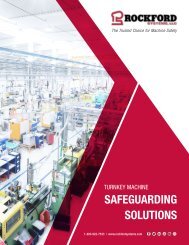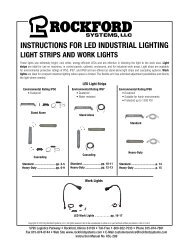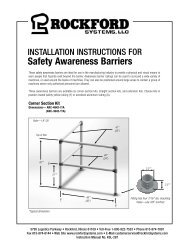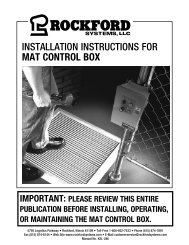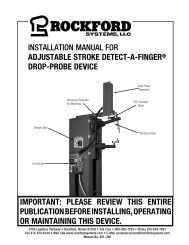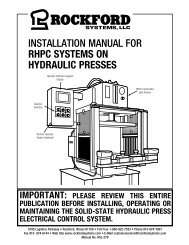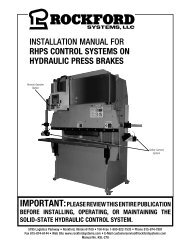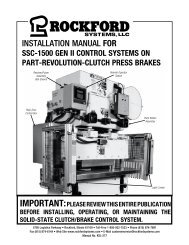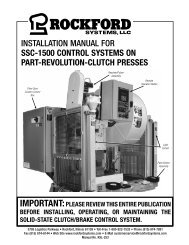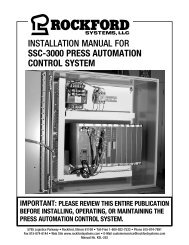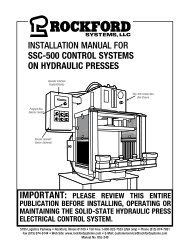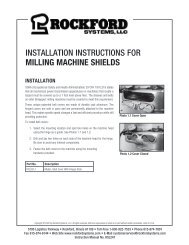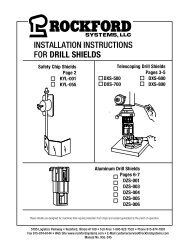Rockford Systems Shields for Safeguarding Machines Catalog
FREE, comprehensive 80-page catalog that features a complete line of equipment to protect operators of cutting and turning machines. These products comply with OSHA and ANSI standards. The polycarbonate and steel shields found in this catalog can be applied to drill presses, lathes, milling machines, bench grinders, band saws, and disc and belt sanders. The catalog also offers emergency-stop devices, disconnect switches, magnetic motor starters, lockouts, and danger signs.
FREE, comprehensive 80-page catalog that features a complete line of equipment to protect operators of cutting and turning machines. These products comply with OSHA and ANSI standards. The polycarbonate and steel shields found in this catalog can be applied to drill presses, lathes, milling machines, bench grinders, band saws, and disc and belt sanders. The catalog also offers emergency-stop devices, disconnect switches, magnetic motor starters, lockouts, and danger signs.
- No tags were found...
You also want an ePaper? Increase the reach of your titles
YUMPU automatically turns print PDFs into web optimized ePapers that Google loves.
INTRODUCTION<br />
INTRODUCTION (CONTINUED)<br />
This catalog offers a variety of equipment including a line of shields<br />
(barriers), cord and plug lockouts, fused disconnect switches, magnetic<br />
motor starters, self-latching emergency stops, and accessories which<br />
are available to meet the electrical energy source portion of these<br />
standards. If a shield is not represented within this catalog, please<br />
contact us <strong>for</strong> an alternative solution.<br />
The shields (barriers) offered in this catalog are usually installed on<br />
drilling machines, lathes, milling machines, grinding machines, band<br />
saws, belt sanders, and disc sanders. Many of the shields can be used<br />
on other types of equipment including woodworking machines. Most of<br />
these shields are intended to deflect chips (swarf), sparks, splashing<br />
coolant, or lubricant away from the operator and other employees in<br />
the machine area. <strong>Shields</strong> will provide visibility to the point of operation.<br />
Although these shields provide some degree of guarding <strong>for</strong> the operator,<br />
they cannot be considered guards. When using these shields, and<br />
be<strong>for</strong>e any of the shields illustrated in this catalog are moved from their<br />
normally applied position, power must always be turned off.<br />
In some cases, more than one type of shield per machine may be<br />
necessary to provide protection. For example, on lathes, a chuck shield<br />
may be required along with a magnetic-base shield where the tool<br />
comes into contact with the workpiece.<br />
This catalog offers several different types of shields. When considering<br />
shielding <strong>for</strong> your machines, be sure to choose the shield that fits your<br />
machining applications and still maintains current levels of productivity.<br />
DRILLING MACHINES<br />
As with other cutting machines, the operator must be shielded from the<br />
rotating chuck and swarf that is produced by the drill bit. A wide variety<br />
of shields can be attached to the machine and used to protect this area.<br />
The ANSI standard <strong>for</strong> drilling machines is ANSI B11.8.<br />
LATHES<br />
There are three main safety considerations <strong>for</strong> lathes (engine, turret,<br />
etc.). One is the rotating chuck that could catch the operator’s clothing,<br />
jewelry, hair, or hand and pull it into the machine. The second is the<br />
hazardous flying chips and splashing coolant that are generated at<br />
the point of operation (where the tool contacts the workpiece being<br />
machined). To protect these areas, two shields can be applied—one<br />
around a portion of the chuck and the other at the point of operation.<br />
See the photo on page 28. Larger sliding shields can protect both<br />
areas, providing the workpiece is not too long. The third is the rotating<br />
transmission components that must be covered to prevent entanglement.<br />
On VTLs (vertical turret lathes), the safety concern is the rotating table<br />
and the point-of-operation swarf. Special barriers may have to be<br />
fabricated around the tables of these machines; shields can be provided<br />
at the point of operation.<br />
If railings are used to keep operators away from hazard areas, these<br />
railings must be 42" above the floor or plat<strong>for</strong>m.<br />
The ANSI standard <strong>for</strong> lathes is ANSI B11.6.<br />
MILLING MACHINES<br />
The main safety consideration <strong>for</strong> milling machines is the swarf that<br />
is generated at the point of operation. Another safety concern is the<br />
tool cutter, which could catch operator’s clothing, jewelry, hair, or any<br />
other part of the body. Usually on smaller mills, the operator and other<br />
employees in the machine area are protected by shields. These shields<br />
can be applied around the perimeter of the table or bed area or close to<br />
the cutter, depending on the size of the workpiece and the application.<br />
On larger milling machines, operators are sometimes protected by<br />
location; however, when working close to a cutting tool, operators must<br />
be protected from swarf.<br />
The ANSI standard <strong>for</strong> milling machines is ANSI B11.8.<br />
GRINDING MACHINES<br />
<strong>Shields</strong> are usually applied to grinding machines to protect the operator<br />
from chips (swarf), sparks, splashing coolant, or lubricant.<br />
Other safety concerns <strong>for</strong> grinders are the adjustment of the work rests<br />
and the adjustable tongues or ends of the peripheral members at the<br />
top of each wheel. Work rests shall be kept adjusted closely to the wheel<br />
with a maximum opening of 1/8". The distance between the wheel<br />
periphery and the adjustable tongue or the end of the peripheral member<br />
at the top shall never exceed ¼".<br />
Grinding machines are covered by OSHA in 29 CFR 1910.215. The ANSI<br />
standards <strong>for</strong> grinding machines are B11.9 and B7.1.<br />
BAND AND TABLE SAWS<br />
<strong>Shields</strong> are applied to band saws and table saws to protect the operator<br />
from flying chips, splinters, and dust. As with other cutting machines,<br />
care must be taken around the moving blade of the machine. Avoid<br />
wearing loose clothing and jewelry; properly restrain long hair.<br />
Band saws and table saws <strong>for</strong> woodworking are covered by OSHA in<br />
29 CFR 1910.212 and 1910.213. The ANSI standard <strong>for</strong> metal sawing<br />
machines is ANSI B11.10.<br />
DISC/BELT SANDERS/GRINDERS<br />
<strong>Shields</strong> can be applied to disc/belt sanders/grinders to protect the<br />
operator from flying chips, splinters, and dust. As with other machines<br />
with rotating parts, care must be taken around the point of operation.<br />
Avoid wearing loose clothing and jewelry; properly restrain long hair.<br />
Disc and belt sanders <strong>for</strong> woodworking are covered by OSHA in 29 CFR<br />
1910.212 and 1910.213. The ANSI standards <strong>for</strong> grinding machines<br />
are B11.9 and B7.1.<br />
LOCKOUT/TAGOUT<br />
As stated in OSHA 29 CFR 1910.147 The control of hazardous energy<br />
(lockout/tagout): “(a)(1)(i) This standard covers the servicing and<br />
maintenance of machines and equipment in which the unexpected<br />
SAFETY SHIELDS | 7




